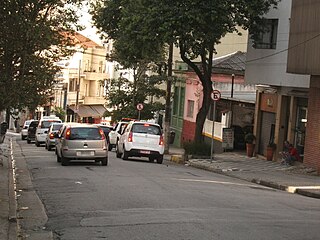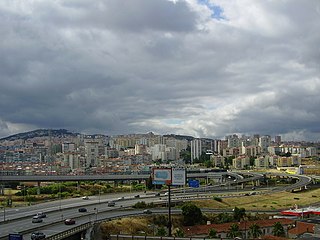
Freguesia, usually translated as "parish" or "civil parish", is the third-level administrative subdivision of Portugal, as defined by the 1976 Constitution. It is also a local administrative unit in the former Portuguese overseas territories of Cape Verde and Macau. In the past, was also an administrative division of the other Portuguese overseas territories. The parroquia in the Spanish autonomous communities of Galicia and Asturias is similar to a freguesia.

Alheira e Igreja Nova is a civil parish in the municipality of Barcelos, Portugal. It was formed in 2013 by the merger of the former parishes Alheira and Igreja Nova. The population in 2011 was 1,456, in an area of 10.17 km².

Alvito e Couto is a civil parish in the municipality of Barcelos, Portugal. It was formed in 2013 by the merger of the former parishes Alvito, Alvito and Couto. The population in 2011 was 1,438, in an area of 8.54 km².

Areias de Vilar e Encourados is a civil parish in the municipality of Barcelos, Portugal. It was formed in 2013 by the merger of the former parishes Areias de Vilar and Encourados. The population in 2011 was 1,879, in an area of 10.17 km².

Carreira e Fonte Coberta is a civil parish in the municipality of Barcelos, Portugal. It was formed in 2013 by the merger of the former parishes Carreira and Fonte Coberta. The population in 2011 was 2,033, in an area of 5.29 km².

Creixomil e Mariz is a civil parish in the municipality of Barcelos, Portugal. It was formed in 2013 by the merger of the former parishes Creixomil and Mariz. It has an area of 6.98 km², and its population in 2011 was 1,208.

Durrães e Tregosa is a civil parish in the municipality of Barcelos, Portugal. It was formed in 2013 by the merger of the former parishes Durrães and Tregosa. The population in 2011 was 1,409, in an area of 6.73 km².

Gamil e Midões is a civil parish in the municipality of Barcelos, Portugal. It was formed in 2013 by the merger of the former parishes Gamil and Midões. The population in 2011 was 1,386, in an area of 5.84 km².

Negreiros e Chavão is a civil parish in the municipality of Barcelos, Portugal. It was formed in 2013 by the merger of the former parishes Negreiros and Chavão. The population in 2011 was 2,364, in an area of 6.96 km². The main monument of Chavão is the parish church, of Baroque style with a few Romanesque elements.

Quintiães e Aguiar is a civil parish in the municipality of Barcelos, Portugal. It was formed in 2013 by the merger of the former parishes Quintiães and Aguiar. The population in 2011 was 1,190, in an area of 7.36 km².

Frei Caneca Street is an important LGBT Street in the city of São Paulo, Brazil, that starts at the Paulista Avenue and ends at Augusta Street. In the street is located the famous gay nightclub A Loca, and the gay friendly Shopping Frei Caneca.

Loures is a city and a municipality in the central Portuguese Grande Lisboa Subregion. It is situated to the north of Lisbon. It was created on 26 July 1886 by a royal decree. The population in 2011 was 199,494, in an area of 167.24 km². It borders the municipalities of Odivelas, Sintra, Mafra, Arruda dos Vinhos, Vila Franca de Xira and Lisbon. The municipality is basically divided in three areas: the rustic one, to the north, the urban one, to the south and the urban-industrial, to the east. Portela de Sacavém is the site of Portugal's largest airport.

Campo Grande is an elevated interchange station on the Yellow and Green Lines of the Lisbon Metro. It has a large bus terminal at ground level and is located on Rua Cipriano Dourado just north of Avenida General Norton de Matos in the Lisbon parish of Campo Grande.

Loures is a civil parish in the municipality of Loures, Portugal. It is an urban parish, part of the city of Loures. The population in 2011 was 26,769, in an area of 32.82 km².

Odivelas station is the northern terminus on the Yellow Line of the Lisbon Metro in the Odivelas neighbourhood, north west of central Lisbon.

Anta is the Portuguese name for about 5,000 megaliths built during the Neolithic period in the area of Portugal. The Anta das Pedras Grandes is a late-Neolithic site located in Casal Nova in the parish of Caneças, in the Odivelas municipality, in the Lisbon District of Portugal. It was classified as a National Monument in 1944. Excavations in the early 21st century suggest that it was originally built as a dolmen or single-chamber megalithic tomb, consisting of a polygonal long chamber with eight supporting stones about 3 metres tall, and a short access corridor. There are traces of a tumulus, and human bones have been discovered. Excavations in the surrounding area also identified a large number of flint chippings, suggesting that the area was used for the production of flint items.










